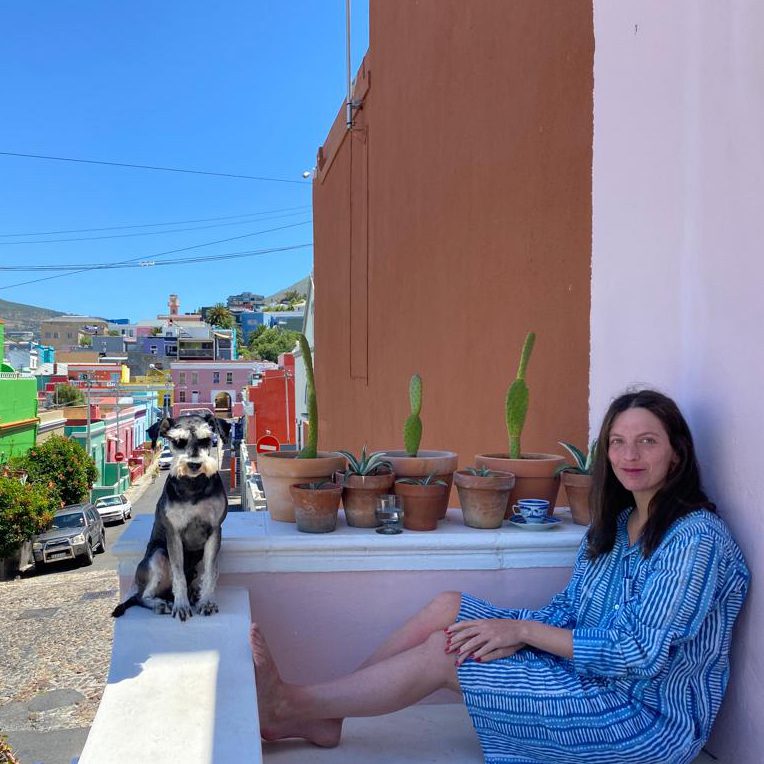Paloma Strelitz, creative director of Patch co-working network and founding member of Assemble, on the sense of connectedness in Cape Town’s Bo-Kaap neighbourhood.
This photo of me was taken by my friend, the ceramicist and illustrator Michael Chandler. I’m sitting on the narrow elevated stoep (veranda) of his pale pink house on the corner of Chiappini and Church Street, right in the heart of the historic Bo-Kaap. The image captures the joy of the morning spent in this complex and compelling Cape Town neighbourhood. The Bo-Kaap sits above Cape Town’s busy mid-rise city bowl and below the slopes of Signal Hill. The area dates back to the mid 1700s and the establishment of the Dutch colony on the Cape of Good Hope. It is composed of steep streets lined by simple low terraces, formerly known as huurhuisjes (rental houses). Initially home to artisans from Europe and freed slaves, this multi-ethnic neighbourhood gathered successive generations of immigrants, many of whom came from India, Sri Lanka, Malaysia and Indonesia. Over time the area became established and recognised as the centre of Cape Town’s Muslim Cape Malay community.
During apartheid’s infamous Group Areas Act, devised to segregate racial groups, the Bo-Kaap was declared a Muslim-only area. This resulted in significant displacements of communities, but uniquely the Bo-Kaap also persisted as the only central neighbourhood where the working-class Muslim community continued to live throughout the apartheid era. This stands in stark contrast to the total destruction of, and displacements from, District Six, the Bo-Kaap’s inner-city sibling across the city bowl, which to this day stands as a seismic scarred urban void near Cape Town’s centre. This brief sketch of the Bo-Kaap’s past is a prompt to engage more deeply in a complex urban history of identity, community and struggle.
So today the Bo-Kaap stands both as a living testament to the brutal loss caused by apartheid, and also, in many ways, to a more equitable vision of Cape Town. Cobbled streets are framed by colourful ribbons of terraces, the brightly painted Cape Dutch and Georgian houses that define this now iconic neighbourhood.
The streets form the centre of communal life; neighbours talk from stoep to street, children play, and men meet at regular intervals outside the Bo-Kaap’s numerous mosques. Many of the Bo-Kaap’s small businesses are family run – such as Atlas Trading, a spice and dry goods store which has operated since 1946. Rose and Wale Streets are the centre of much of the neighbourhood’s commercial and civic life. At the intersection of these two streets is the Rose Corner Superette, one of the corner shops that are core to Bo-Kaap life. A favourite stop for me is the food stall run by Warida Cornelius, where I savour her freshly fried samosas and koesisters (spiced syrupy donuts dusted with coconut).
This is a neighbourhood where feelings of connection come easily – enhanced by an intimate layering of private and public spaces. For example, at Michael’s house, we have breakfast in a small inner courtyard – a physical retreat to a private interior world, and then by stepping out on his stoep we cross a threshold into the public ‘interior’ of the Bo-Kaap street. Set across, on the adjacent corner to me in the image, is the Shafee Mosque, whose cream minaret is one of the many that orientate the neighbourhood and define the area’s roofscape. The call to prayer enfolds the area five times a day – imbuing the neighbourhood’s daily rituals with a palpable collective consciousness.
How do you build such a powerful and tangible sense of connectedness? There are lessons here: dense and varied low rise housing, strong visual coherence through the repeated pattern of physical form, space for individual agency and expression from the painted facades to carefully maintained stoeps, walkable streets with active frontage from shops and restaurants close by, and a regular thrum of visible everyday life connecting the community, the homes, and the streets. As I sit on this stoep, sipping my coffee in the morning sun, I look out across the Bo-Kaap and consider this neighbourhood’s empowering lessons for creating more connected cities; physically, socially and culturally.
Source: Architecture Today

